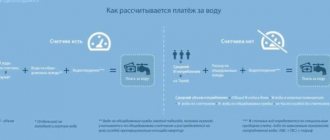Decoding the abbreviations in the housing and communal services receipt for heating. KPU, IPU - what is it?
Water, electricity, gas - all this is necessary for people to live comfortably in houses and apartments. Payment for these resources is mandatory, but many people do not understand the abbreviations found on utility bills.
In the context of a constant increase in tariffs, the number of questions arising in this regard is becoming more and more, and errors in calculations are becoming more common, so every payer should know the definitions of the main abbreviations, which will be given in this article.
We solve legal problems of any complexity. #Stay home and leave your question to our lawyer in the chat. It's safer this way.
Ask a Question
Show content
CPU
The receipt that you received may contain a phrase such as “water drainage system KPU” or, if you pay for water supply, “HVS KPU” / “DHW KPU”.
- In the first case, it means draining all wastewater. In this case, the total amount of hot and cold water spent for general household needs goes into the sewer system is taken into account. Payment is made not only for the sewer system itself, but also for the drainage, disposal, transportation and further purification of consumed water.
- In the second case, water supply means the direct supply of water to the apartment.
This service includes:
- continuous heating of hot water;
- disinfection by cold, after which it becomes suitable for drinking.
IPU (individual metering devices)
These technical means are designed to calculate the resources consumed in a single apartment, i.e. the tenant himself can regulate expenses and fees for them.
There are two methods of accounting for expenses:
- collective;
- individual (using IPU).
- In the first case, a common meter is installed for the entire house, and its readings are divided in equal shares between the number of residents registered in this house. In this situation, people must pay their share regardless of whether they are at home or not during this period.
- In the second case, meters are installed in each apartment and people pay only for what they actually used for a certain period. This method is considered the most effective and fair for calculating consumed resources (how to calculate the cost of heating per 1 sq. m in 2019?).
Utilities of one building are resources that are used in the process of maintaining and operating common property in an apartment building.
What are the ODN services for which residents will be charged? Here's a short list:
- water, gas, heat supply to non-residential premises owned by an apartment building;
- cleaning these premises;
- improvement of adjacent territories;
- ensuring the operation of the elevator, intercom, video surveillance system, installation of a common antenna;
- heating and lighting of common property (how are heating fees determined in Russia?).
In addition, Article 36 of the Housing Code of the Russian Federation establishes a list of common property in apartment buildings. It includes:
- elevators and elevator shafts;
- corridors;
- attics and basements;
- roofs;
- stairs and landings;
- premises designed to satisfy social and other needs (shops, sections, etc.);
- equipment belonging to the home.
GCAL
This abbreviation stands for a unit of measurement of consumed resources - gigacalorie.
Here are the values from which Gcal is derived : 1 gigaCal (Gcal) = 1000 Mcal = 1000000 kcal = 1000000000 Cal.
Now, when you see this abbreviation on your utility bill, you can easily understand that this is the amount of resources that you have used and that you should pay for a certain period of time.
ODPU / DPU
This abbreviation hides communal and household metering devices. Despite the fact that there are many different meters, such as IPU or KPU, general house metering devices are necessary in apartment buildings.
The thing is that in the absence of ODPU, each apartment will have to install at least 4 different types of meters (for electricity, heat, water and gas) or residents will have to overpay.
The installation of such a meter is mandatory for all apartment buildings in accordance with Federal Law No. 261, which was issued back in 2009. However, despite the fact that the law mandated that installations be completed by 2012, many homes have still not done so.
What is thermal energy in the housing and communal services bill?
This term refers to the cost of heating cold water. It was already mentioned above that the calculation of hot water supply consists of two parts, one of which includes such a value as “thermal energy”.
The amount to pay for this service is calculated taking into account the following components:
- thermal energy tariff;
- expenses required to maintain a centralized hot water supply system;
- cost of thermal energy loss in pipelines;
- costs necessary to transport hot water.
The amount of thermal energy is determined based on general house values.
Now, after reading this article, you don’t have to worry about utility bills, because you know how the standard abbreviations stand: KPU, IPU, ODN, Gcal, ODPU, DPU.
, please select a piece of text and press Ctrl+Enter.
We solve legal problems of any complexity. #Stay home and leave your question to our lawyer in the chat. It's safer this way.
Ask a Question
Source: https://pravovoi.center/zpp/nekachestvennyj-uslugi-zhkh/pravila-teplosnabzheniya/plata-za-otoplenie/abbreviatury-v-kvitancii.html
Calculation of ODN for electricity in an apartment building
Most apartment buildings are already equipped with common building meters for metering the consumption of utility resources (electricity, water and heat). Many apartments have individual meters, according to which residents submit readings and utility bills are calculated. Essentially, common house needs are the difference between the readings of common house and individual appliances. For those owners who do not have meters in their apartment, ODN is distributed based on the ratio of the apartment’s area to the total living space of the house.
We recommend reading: Sell a Dacha Land Plot Without Land Surveying in 2020
Previously, the utility organization that managed the house could set the ODN for electricity by subtracting the energy consumed from individual apartment meters and general house readings. It was not possible to control how correctly each owner was invoiced under the ODN. And here some cunning, or, more simply put, fraud, of the management organization was acceptable.
Payment for electricity supply in receipt
Menu
– Tax law – Payment for electricity supply in the receipt
Previously, this expense was “hidden” in the article “maintenance and repair of housing,” but after the publication of Government Decree No. 354, lighting of public places became a separate service.
What is included in MOS electricity?
Article 36 of the Housing Code of the Russian Federation includes in common areas (MOP): elevator, corridors, platforms, attics, basements, etc. non-residential premises in which electricity is used. In accordance with Art.
158 of the housing legislation, each owner of an apartment in a multi-storey building must regularly pay housing and communal services receipts related to utilities and the maintenance of his own home, as well as take a share in the care of the common space.
For your information
Electricity consumed by light bulbs on sites and in basements was always paid for, but at the expense of the “housing maintenance” line.
Having received receipts for payment of housing and communal services for July, many residents of the Odintsovo district paid attention to the new line in the fat - “Electricity supply to the MOP.” This innovation has raised many questions among citizens, and some have raised dissatisfaction and indignation. “Another fool and pumping money from the population?” — members of the Odintsovo-INFO forum sounded the alarm.
Previously, apartment owners also paid for energy supply in common areas, only the payment was included in the tariff “and repairs of residential premises.” And from July 1, electricity costs were excluded from this tariff, and they were placed on a separate line in the receipt - “Electricity supply to the MOP.”
“Previously, electricity was included in the tariff for servicing public areas, but now it has been allocated as a separate line.
Explanation of the abbreviation: thermal energy metering units.
DSCPT
Stands for “additional cable program television systems.” This column is not available on payment cards in all regions. It constitutes a fee for the provision of telecommunication services, maintenance of a common house antenna, etc.
DSKPT can be appealed by a citizen in a situation where he uses cable TV and an antenna.
POVK
In order to understand what POVK means, you need to refer to the norms of housing legislation. This is an additional fee for providing heat to the apartment. A couple more letters are added to this abbreviation, for example, ТХВ.
APPP
APPP involves citizens paying for the development and maintenance of systems that protect the house from sudden fire.
The presence of a specialist must be ensured by the chairman of the HOA or the management company responsible for maintaining the house.
Cost calculation
The payment for MOP electricity in the housing and communal services receipt is determined in different ways:
- If the house does not have a common meter, then according to the formula:
VMOS = NMOS * Pl. Non-residential* Sq./Sq. total sq.
Where,
NMOP is the monthly standard value of electricity consumption for each family member, determined by RF PP No. 306 in 2006,
Pl. unlived - size of common premises,
Sq.m - area of occupied living space,
Total area - the area of the entire multi-apartment building excluding non-residential premises.
The fee is calculated as follows:
Pmes.
Payment for GP electricity supply what is it
Attention, the Code of Administrative Offenses of the Russian Federation establishes liability for violation of labor legislation, which involves the imposition of an administrative fine on officials in the amount of one thousand to five thousand rubles, on persons carrying out entrepreneurial activities without forming a legal entity, in the amount of four thousand to five thousand rubles or an administrative fine suspension of activities for up to ninety days. (Part two as amended by Federal Law dated April 6, 2011 66-FZ) (see the text in the previous edition) 4. Copies of the court decision to bring the perpetrator to criminal liability can be appealed in the manner established by Chapter 30 of the Code of Administrative Offenses of the Russian Federation. Code of Administrative Offenses of the Russian Federation Article 30.2. The procedure for filing a complaint against a decision in a case of an administrative offense 1.
Payment for GP electricity supply - what is it?
- in Government Decree No. 491 of August 13, 2006, approving the rules for maintaining common space and changing fees in connection with emergency situations.
PP No. 354 states that the amount of payment in the housing and communal services receipt for MOP electricity depends on the difference between the data of the collective meter and the readings of individual devices.
The resulting value is distributed among all residents of the high-rise building.
What is MOP electricity in a housing and communal services receipt?
Attention
Electricity MOP (the concept applies only to multi-apartment buildings) is a residential utility service providing electricity to common areas.
At the same time, all residential apartments in which metering devices are installed consumed 10,000 kW. The total amount of kilowatts in a non-metered residential space is 5000 kW. The sum of residential square meters in the entire house is 5000 m2. The dimensions of a single apartment are 40 sq.m. The tariff is the same - 3.72 rubles/kWh.
(16000-10000-5000)*40/5000 = 8 kW * 3.72 = 29.76 rubles.
What affects the payment amount?
Residents of an apartment building that is not equipped with a collective meter pay for electricity for MOP in accordance with current standards by distributing it between apartments on a shared basis.
It is also interesting that unauthorized connection to the general house network and any losses of electricity will be paid by all residents, so it is worth controlling who connects what and how they pay for it, and exclusively on their own.
If we talk about reducing payments under this item, then it is worth identifying an initiative group of residents who will monitor the readings taken from the ODPU and will be able to monitor unauthorized connections in order to prevent these bills from being distributed to all residents.
Source: https://yurist-buhgalter.ru/oplata-gp-elektrosnabzhenie-v-kvitantsii
Readers discuss: About paying for electricity for MOP
The newspaper editor received a letter from our reader S.I. Borzdogo, in which he reflects, analyzes what complicates the lives of many residents of the area today, “especially the elderly and the poor,” dwelling in detail on one pressing problem - charging for the use of electricity in public places.
In his letter, Sergei Ivanovich writes indignantly that Tulaenergosbyt does not control the electricity consumption of residents of apartment buildings, but only sends out receipts for payment for common areas according to common building meters. “It turns out that conscientious residents pay both for those who steal electricity and for those who do not pay at all. The Venevsky site of Tulaenergosbyt offers residents of apartment buildings to control each other: how and who uses electricity.” Sergei Ivanovich believes that by their actions “they are pushing to worsen the antagonism between residents,” and that site workers should and are obliged to independently control the use of electricity by residents, and “not send inflated receipts for electricity payments to bona fide payers.” In a letter to S.I. Borzdy writes that “for nine months, residents of the area have been persistently trying to find out what rules are used to calculate electricity consumption in the MOP, but so far no intelligible answer has been received.” In this regard, residents of the area contacted the prosecutor's office, and the prosecutor sent the case to court. The court decided to recalculate in favor of the residents of the area. “The Venevsky section of Tulaenergosbyt OJSC issued a warning in its payments for October that payment of the debt must be made no later than December 10, 2011, including according to the MOP. In case of late payment, a penalty will be charged in accordance with Article 155 of the Housing Code of the Russian Federation dated December 29, 2004 No. 188-FZ.
We recommend reading: Can a TV refrigerator be taken away for debts to the bank?
MOP electricity in housing and communal services receipt
As part of the reform of public utilities, all apartment buildings are equipped with common building electricity meters. This is necessary to determine the number of kilowatts consumed for general purposes. Residents of high-rise buildings continue to argue about the correctness of the calculations and the lack of accounting for the share of electricity consumed.
Normative base
Responsibility for the maintenance of property in joint use is regulated by Art. 30 clause 4 of the Housing Legislation, as well as Art. 209-210 of the Civil Code.
The legality, validity and legality of including MOP electricity in the general housing and communal services bill for the general needs of the house is determined by Government Resolution No. 354, adopted on May 6, 2011.
, describing the procedure for providing utility services.
The requirement to make a payment for MOP electricity spent on the general needs of an apartment building is also stipulated:
- in Federal Law No. 261, dated November 23, 2009 and defining ways to save energy and increase the efficiency of the existing energy system;
- in Government Decree No. 491 of August 13, 2006, approving the rules for maintaining common space and changing fees in connection with emergency situations.
PP No. 354 states that the amount of payment in the housing and communal services receipt for MOP electricity depends on the difference between the data of the collective meter and the readings of individual devices. The resulting value is distributed among all residents of the high-rise building.
Is the replacement of light bulbs in the entrance included in the MOP electricity payment?
Payment for maintenance of common areas only includes electricity used in common areas. Replacing light bulbs on sites and entrances is the responsibility of an electrician. The presence of a specialist must be ensured by the chairman of the HOA or the management company responsible for maintaining the house.
Payment for electricity MOP
In accordance with current regulations (Articles 36, 39 and 158 of the Housing Code of the Russian Federation, PP No. 491 of August 13, 2006), owners of residential square meters are required to participate in the repayment of general household electricity consumption.
The amount of payment for the total kilowatts of MOP in the housing and communal services receipt is calculated on the basis of Resolution No. 354, adopted on May 6, 2011.
Actions if the amount for MOP electricity exceeds the payment for electricity for individual use
Payments for the benefits of civilization based on meter readings are considered the most reliable, but with electrical energy this is not always the case.
The indicator depends on the presence of commercial facilities in the house - shops, medical centers, private kindergartens, etc.
Not every entrepreneur is conscientious, so payment for lighting and advertising signs is sometimes “dissolved” in MOP electricity.
To be sure that the housing and communal services receipt pays only for the electricity actually spent by the MOP, the owners of housing in an apartment building (HOA, management company, etc.) must invite a specialist who can take an inventory of the equipment and determine the connection diagram for commercial neighbors.
Possible problems and optimal behavior options are presented in the table.
| Problem | Possible behavior |
| The operation of energy equipment is not controlled by anyone (light bulbs are lit in public places around the clock) | You can deal with the problem:
|
| High deterioration of in-house wiring. | A collective application to the management company or other service organization, reflecting the requirement to repair the electrical network. |
| Illegal behavior of entrepreneurs - owners of shops, hairdressers, etc. | File a complaint about “uninvited” neighbors to a power grid branch or to the police department. |
| Often, defaulters, disconnected from the energy supply for non-payment, instead of paying off debts, are included in the intra-house network on their own. | In this case, the following order should be followed:
|
| Lack of personal meters in apartments. If the number of kilowatts consumed monthly by such a resident exceeds the standard value, then the difference is distributed among the neighbors. | Require the installation of individual metering devices. |
Is it possible to refuse payment?
In accordance with the rules for the provision of communal benefits to owners and users in multi-apartment buildings and residential buildings, approved by Government Decree No. 354 of May 6, 2011.
, payment for electricity consumption for MOP in the housing and communal services receipt in the presence of a common house meter is distributed among the owners in proportion to the occupied square meters.
If a multi-storey building is not equipped with a collective meter, then the MOP electricity is calculated based on the standard established in the region.
The rules require that payment for kilowatts used in common areas be made even if personal square meters are empty for a long time, because the formula is based on the area of the apartment.
Consequences of non-payment
Management companies and homeowners associations are responsible for timely payments based on agreements with utility companies.
Ignoring the requirements allows the MOP energy supplier to solve the problem in court. Servants of Themis usually satisfy these types of claims.
Service organizations similarly resolve the issue with homeowners.
The housing and communal services sector is constantly being updated, and apartment owners are not always aware of these innovations. Likewise, the line “MOP electricity” in the housing and communal services receipt became an unpleasant surprise for many. Failure to pay utility bills on time, including in public areas, can result in fines, penalties and litigation.
Nuances
The owner of an apartment in a multi-storey building is obliged to participate in payments for general house electricity costs in accordance with the share of his living space.
That is, the amount of payment directly depends on the area of the apartment. This procedure can be followed if the building is equipped with a collective meter.
In a house that is not equipped with a metering device, payments for MOP electricity are made based on the standards established in the region.
Until September 2012, different rules were in effect: the share of expenses for MOP was proportional to personal expenses. But this caused serious disputes between neighbors living on similar square meters, but spending different amounts of kilowatts for their own purposes.
Property owners, outraged by large general household expenses, must initiate a meeting and decide on the best ways to combat it: install personal meters, provide readings in a timely manner, eliminate illegal connections and theft on the part of apartment and business owners. You can combat the high energy consumption of MOS by installing energy-saving equipment, motion sensors and other devices that allow you to automatically turn on and off the light bulbs.
Source: https://uslugi-zhkh.ru/elektrosnabzhenie/elektroenergiya-mop-v-kvitantsii-zhkh/
Decoding the housing and communal services receipt 2020, how to understand the services and what is included in them
This is due to the fact that these organizations are direct suppliers of utility services, and therefore charge directly.
A housing and utility bill looks like this: it is a written document that lists the services for which a fee is charged. Tariffs are also indicated there. The rent act has the following content:
- Address and location of residential premises.
- Indication of the payer.
- QR code.
- Tariffs that are applied during calculation.
- Data on the services provided.
- The name of the service provider and its bank details.
- Total amount to be paid.
Depending on the management company, the receipt may also include services for garbage removal, sewerage, general house needs, heating, etc. Before you understand the difference between these concepts, you need to understand the decoding of this abbreviation.
Lighting of common areas, cost calculation
Previously, this item was part of the article “repair and maintenance of housing”. But in Decree of the Government of the Russian Federation No. 354 of 05/06/2011 “On the provision of public services”, electricity supply in public places of apartment buildings was allocated as a separate service.
Expenses for the provided housing and utility services, including the maintenance of the MOP, in accordance with Art.
39 clause 1 of the Housing Code of the Russian Federation is borne by the owners of residential and non-residential premises.
Also, in accordance with Resolution No. 354, the owner is obliged to pay monthly for the electricity supply to the MOP.
The indicator is obtained using a special communal meter, which should be in every apartment building.
Cumulative electricity consumption in all residential premises.
For this indicator, data from individual apartment meters or consumption standards for apartments without them are taken.
Electricity supply on receipt
entails the imposition of an administrative fine on citizens in the amount of ten thousand to fifteen thousand rubles; for officials - from thirty thousand to eighty thousand rubles or disqualification for a period of one to two years; for legal entities - from one hundred thousand to two hundred thousand rubles.
Procedure for imposing a fine: The owner of the electrical network (management or resource supply organization) to which the violator of the restriction regime is connected submits a statement to the police.
The district commissioner draws up a protocol on the administrative offense and sends it to the magistrate's court.
If the magistrate finds the administrative offense proven, he decides to impose a fine.
2. The bank deposit was seized on the basis of a court order dated October 25, 2017. The official was an electricity supply company.
The debt for services was fully paid in June 2020, but I didn’t even know about the existence of the court order, because...
Power supply mop gp
- Aug 27, 2016
- Feb 24, 2017
- Aug 27, 2016
- Aug 27, 2016
MosObleIRC includes in the payment document
From April 2020, it is excluded from payment documents generated by the RCC. Charges for electricity supply are made on the basis of an agreement concluded between Mosenergsbyt JSC and MosOblEIRTS LLC.
Calculations are made according to approved tariffs and standards, as well as taking into account the information received from the readings of individual metering devices.
The payment document provides a tear-off form for transmitting electricity meter readings. MosObleIRTs recommends monitoring the service life of metering devices.
After the meter has gone beyond the interverification
MosOblEIRTS explains: how to pay for “electricity supply”?
At the same time, the possibility of direct payment to Mosoblgaz and Mosenergosbyt remains. At the end of each month, MosOblEIRTS, as a paying agent, receives registers with charges from the gas and electricity supplier, taking into account the payments made.
This rule is mandatory. The only exception is the fee for voluntary insurance.
As a result, by paying less than the accrued amount, the subscriber creates a debt for all housing and utility services.
Power supply
Heirs of the same line inherit in equal shares, with the exception of heirs inheriting by right of representation (Article 1146) or by hereditary transmission (Article 1156).
Refusal in favor of any of the specified persons is not allowed: from property inherited by will, if all the property of the testator is bequeathed to the heirs appointed by him, and he is recognized by the court as incompetent (part two of paragraph 4 of Article 574), they filed a claim in court to determine the procedure execution of a court decision.2.
The guardian does not have the right, without the prior permission of the guardianship and trusteeship body, to carry out, and the trustee - to give consent to, transactions involving the alienation, including the exchange or donation of the ward's property, leasing it, for free use or as a pledge, transactions entailing renunciation of the rights belonging to the ward, division of his property or allocation of shares from it, as well as any other transactions entailing a decrease in the property of the ward. (as amended by Federal Law dated July 24, 2007 211-FZ)
Decoding of utility bills for housing and communal services, which is included in the rent receipt
dated December 29, 2014
Only an approximate form of rent receipts has been approved.
However, this document is only advisory in nature, its use is not mandatory. Due to changes in housing legislation that came into force at the beginning of this year, this sample model has also undergone some additions.
In fact, any receipt should include the following information:
- about the payer and recipient of payment for housing and communal services (full name, name of organization, TIN, bank details, personal account number);
- reference Information.
- information about the residential premises (area of the apartment, the house as a whole, address, number of residents);
- calculation of payments for each type of services provided;
Despite possible differences in appearance, in general, any payment card consists of several sections:
Payment for electricity in a separate column on the receipt
The management of Housing and Public Utilities Management Company OJSC also decided to equip houses, where technically possible, with communal metering devices by the end of this year, which will allow each house to independently regulate internal resource consumption.
Starting from July 1, electricity, which relates to the common areas of an apartment building, was placed in a separate category, which makes it possible to understand where, how much and for what we pay. Here we are talking about
What is the electricity supply on the receipt?
The driveway meter is not considered when calculating the fee for MOP
This document regulates the organization of accounting for general household consumption of household and utility services. In particular, a rule appeared there according to which it is necessary to charge for electricity not only consumed in apartments, but also used for general needs. In 2011, the government also adopted another regulatory act (No. 354) systematizing:
- its frequency;
- issues of payment for housing and communal services;
- rights, and equally obligations of the parties, etc.
- the procedure for accounting for resources;
According to Resolution 354, tariffs for the following utilities are also now calculated:
- hot water supply;
- heating;
- electricity.
Thus, since 2011, electricity spent for the common needs of all residents is no longer included in the maintenance of housing and a different standard is used in the calculation.
Accordingly, the cost was entered as a separate line in the bills.
MOP electricity in housing and communal services receipt
and defining ways to save energy and increase the efficiency of the existing energy system; dated August 13, 2006, approving the rules for maintaining common space and changing fees in connection with emergency situations.
PP No. 354 states that the amount of payment in the housing and communal services receipt for MOP electricity depends on the difference between the data of the collective meter and the readings of individual devices. The resulting value is distributed among all residents of the high-rise building.
AttentionElectricity MOP (the concept applies only to multi-apartment buildings) is a residential utility service for providing electricity to common areas.
non-residential premises in which electricity is used.
sovetnik36.ru
— Those who develop laws and introduce tariffs must answer why this was done. This is an innovation not only for the municipal unitary enterprise "UZhKh", but for all management companies.
Attention We are simply executors of those decisions that are made at the Government level.
Thus, homeowners were once again clearly demonstrated that they are responsible not only for their apartment, but for the entire house.” Common areas, attic, basement, elevator facilities - all consumed electricity in an apartment building is displayed on the meter, according to the readings of which the monthly cost of “MOP power supply” is calculated.
“We bill the amount to be paid according to the meters installed in the houses.
- 2 Calculation of lighting costs
- 4 Liability for non-payment
- 1 Concept of MOS lighting
- 3.1 Energy losses in MKD
- 3 Problems when calculating MOS lighting
- 1.1 Who pays
lic-r.ru
Considering the fact that the problem of payment of utility bills by the owners of premises appeared not so long ago, local judges rarely have to deal with cases of debt collection from owners of residential premises in apartment buildings.
However, such cases are no different, for example, from the collection of arrears from owners for payment for residential premises or the use of utilities. How much should the owner pay? Separately, the issue of distributing the cost of paying for electrical energy between the owners, consumed for the needs of the entire house, should be considered.
Info In a number of older buildings, a collective meter is not installed, so the fee for lighting public premises is calculated according to the electricity consumption standards established in each region and distributed in the same way as the previous method.
Source: https://kb-gorizont.ru/oplata-gp-ehlektrosnabzhenie-v-kvitancii-50847/
Energy supply of public areas hfcxtn 2020
The purpose of the tariff specified in paragraph 3 of Appendix No. 2 of the Resolution has also changed. Previously, this tariff, subject to the requirements specified in paragraph 3 of Appendix No. 2, could only be applied in apartments of multi-apartment residential buildings. Currently, this tariff is also applicable to single-family or semi-detached residential buildings. Thus, electrical energy, subject to its use, including for the needs of heating and hot water supply in residential buildings (apartments), not equipped in the established manner with centralized heat and gas supply systems and equipped in the established manner with electric stoves, in the absence of a separate (additional) an individual metering device for electrical energy consumption for heating and hot water supply will be calculated at a tariff of 7.61 kopecks. for 1 kWh.
Resolution of the Council of Ministers of the Republic of Belarus dated July 1, 2020 No. 442 introduced a number of changes to Resolution of the Council of Ministers of the Republic of Belarus dated December 30, 2013 No. 1166 “On establishing gas prices for the population, tariffs for electric and thermal energy, approving costs per unit of utility services provided to the population gas and energy supply organizations of the Ministry of Energy and invalidation of certain resolutions of the Council of Ministers of the Republic of Belarus and certain structural elements of resolutions of the Council of Ministers of the Republic of Belarus" (hereinafter referred to as the Resolution).
We recommend reading: Travel card for schoolchildren in Moscow Cost 2020
You can now pay for electricity using the “My Payments” service
Using the “My Payments” service of the mos.ru portal, you can now pay your electricity bills.
Previously, users could pay for electricity only through a catalog or through a widget in their personal account.
At the same time, to pay, citizens were redirected to a third-party bank website, where the operation was completed. Now users can pay their bill immediately on mos.ru.
“Now users of the mos.ru portal have another convenient way to pay for housing and communal services online. Citizens can use not only the catalog of services, but also the “My Payments” service to check charges and immediately pay for utilities, including electricity bills, a single payment document (UPD) and MGTS communication services. The advantage of the payment service is that it allows you to pay one, several or all bills at one time,” said the press service of the Moscow Information Technology Department.
Through the “My Payments” service, users can not only pay electricity bills, but also transmit current electricity meter readings from the 15th to the 26th of each month.
The button for transmitting meter readings (“Add meter readings”) is located immediately below the line of the charged charge and is activated only during this period. By clicking on it, the user will see a pop-up window for entering readings.
It will also show the tariff and the last transmitted readings, if any.
How to pay electricity bills through the “My Payments” service
In order to pay electricity bills and transfer meter readings in the “My Payments” section, you must save the personal account number of Mosenergosbyt JSC in your personal account of the mos.ru portal in the “Real Estate” section, as well as the number of the electricity meter.
After this, electricity bills will be displayed in the “My Payments” service automatically along with other charges. The user will see the category and name of the payment (“Apartments, non-residential premises, utilities”, “Electricity bill”), as well as the estimated payment period. The account is displayed collapsed. By clicking on it, you can see the payment receipt itself and, if necessary, print it.
To pay, you can use a bank card, mobile phone account or e-wallet. At the same time, the card details, number and e-wallet data can be saved so that you do not have to enter them again next time. All data is securely protected.
You can also pay for housing and communal services and transfer water and electricity meter readings to mos.ru using the services “Receiving readings and paying for electricity”, “Receiving readings from water meters” and “Receive and pay for a single payment document (UPD)”. They are located in the service catalog of the mos.ru portal.
This can also be done using the “Utilities” widgets in the user’s personal account. Widgets save water and electricity meter readings transmitted for previous billing periods.
In addition, using widgets, residents can enter data on water meters two months in advance.
Services for paying for EPD and transmitting water and electricity meter readings are also available in the Moscow State Services mobile application.








